Students can download 10th Social Science Geography Chapter 4 Resources and Industries Questions and Answers, Notes, Samacheer Kalvi 10th Social Science Guide Pdf helps you to revise the complete Tamilnadu State Board New Syllabus, helps students complete homework assignments and to score high marks in board exams.
Tamilnadu Samacheer Kalvi 10th Social Science Solutions Geography Chapter 4 Resources and Industries
Samacheer Kalvi 10th Social Science Resources and Industries Text Book Back Questions and Answers
I. Choose the correct answer
Question 1.
Manganese is used in:
(a) Storage batteries
(b) Steel Making
(c) Copper smelting
(d) Petroleum Refining
Answer:
(b) Steel Making
Question 2.
The Anthracite coal has
(a) 80 to 95% Carbon
(b) Above 70% Carbon
(c) 60 to 7% Carbon
(d) Below 50% Carbon
Answer:
(a) 80 to 95% Carbon
Question 3.
The most important constituents of petroleum are hydrogen and:
(a) Oxygen
(b) Water
(c) Carbon
(d) Nitrogen
Answer:
(c) Carbon
Question 4.
The city which is called the Manchester of South India is
(a) Chennai
(b) Salem
(c) Madurai
(d) Coimbatore
Answer:
(d) Coimbatore
![]()
Question 5.
The first Jute mill of India was established at:
(a) Kolkata
(b) Mumbai
(c) Ahmedabad
(d) Baroda
Answer:
(a) Kolkata
Question 6.
The first Nuclear Power station was commissioned in
(a) Gujarat
(b) Rajasthan
(c) Maharashtra
(d) Tamil Nadu
Answer:
(c) Maharashtra
Question 7.
The most abundant source of energy is:
(a) Biomass
(b) Sun
(c) Coal
(d) Oil
Answer:
(b) Sun
Question 8.
The famous Sindri Fertilizer Plant is located in
(a) Jharkhand
(b) Bihar
(c) Rajasthan
(d) Assam
Answer:
(a) Jharkhand
Question 9.
The nucleus for the development of the chotanagpur plateau region is:
(a) Transport
(b) Mineral Deposits
(c) Large demand
(d) Power Availability
Answer:
(b) Mineral Deposits
![]()
Question 10.
One of the shore-based steel plants of India is located at
(a) Kolkata
(b) Tuticorin
(c) Goa
(d) Visakhapatnam
Answer:
(d) Visakhapatnam
II. Match the following
Question 1.
Match the Column I with Column II.
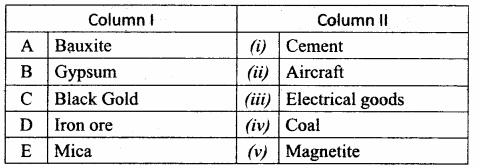
Answer:
A. (ii)
B. (i)
C. (iv)
D. (v)
E. (iii)
Question 2.
Match the Column I with Column II.

Answer:
A. (v)
B. (iv)
C. (i)
D. (ii)
E. (iii)
![]()
III. Answer the following questions briefly
Question 1.
Define the resource and state its types.
Answer:
Any matter or energy derived from the environment that is used by living things including humans is called a natural resource.
Types of Natural Resources are:
- Renewable and
- Non – renewable resources.
Question 2.
Name the states that lead in the production of Iron ore in India.
Answer:
Jharkhand is the leading producer of Iron ore (25%), other states are Odisha (21%), Chattisgarh (18%), Karnataka (20%), Andhra Pradesh (5%) and also the state of Tamil Nadu.
Question 3.
What are the minerals and its types?
Answer:
A mineral is a natural substance of organic or inorganic origin with definite chemical and physical properties.
Types of Minerals are:
- Metallic minerals
- Non – metallic minerals.
Question 4.
State the uses of Manganese.
Answer:
- Manganese is a silvery grey element always available with iron, laterite and other minerals.
- It is very hard and brittle. So it is used for making iron and steel to give strength.
- It also serves as raw materials for alloying.
- It is also used in the manufacture of bleaching powder, insecticides, paints and batteries.
Question 5.
What is natural gas?
Answer:
It usually accompanies petroleum accumulations.
[OR]
Natural gas is an important clean energy resources found in association with or without petroleum. It is used as a source of energy as well as an industrial raw material in the petrochemical industry. It is considered an eco-friendly fuel because of low carbondioxide emissions.
![]()
Question 6.
Name the different types of coal with their carbon content.
Answer:
Based on carbon content coal is classified into
- Anthracite – contains 80% to 90% carbon.
- Bituminous – contains 60% to 80% carbon.
- Lignite – contains 40% to 60% carbon
- Peat – less than 40% carbon
Question 7.
Mention the major areas of jute production in India.
Answer:
West Bengal, Andhra Pradesh, Bihar, Uttar Pradesh, Assam, Chattisgarh, Odisha are the major jute producing area.
Question 8.
Name the important oil producing regions of India.
Answer:
West coast: Mumbai high, Gujarat coast, Basseim, Aliabet (South of Bhavanagar), Ankleshwar, Cambay – Luni region, Ahmedabad -Kaloi region and Punjab – Haryana.
East Coast: Brahmaputra valley, Digboi, Nahoratitya, Moran-Hugrijan, Rudrasagar-Lawa (Assam region), Surrma Valley. Andaman and Nicobar, Gulf of Mannar, Punjab. Haryana, Baleshwar coast.
![]()
IV. Distinguish between
Question 1.
Renewable and non-renewable resources
Answer:
Renewable resources:
- These resources can be replenished after utilization.
- Abundantly available in nature.
- Eg: Sun energy, Wind etc.
Non-Renewable resources:
- These resources cannot be regained after utilization.
- Limited stock take millions of years for formation.
- Eg: Minerals
Question 2.
Metallic and non-metallic minerals
Answer:
Metallic minerals:
- These minerals contain one or more metallic elements.
- They can be further classified into ferrous and Non-ferrous minerals.
- Eg: Iron-ore, Manganese
Non-Metallic minerals:
- These minerals do not contain metal in them.
- They can be classified into energy fuels and construction minerals.
- Eg: Coal, Petroleum, lime stone, Gypsum.
Question 3.
Agra based industry and mineral based industry.
Answer:
Agro based industry:
- These industries obtain raw materials from agricultural products.
- Eg: Cotton textile industry, Jute mills, Silk industry, Sugar industry etc.
- Labour intensive
Mineral based industry:
- These industries obtain raw materials from metallic and non- metallic minerals.
- Eg: Coal industry, Iron and Steel industry etc.
- Capital intensive
Question 4.
Jute industry and sugar industry.
Answer:
Jute industry:
- Second largest textile industry.
- Jute fibre is the basic raw material.
- Gunny bags, Canvas, pack sheets,Cordage are some of the Jute products.
- Concentrated in and around West Bengal.
Sugar industry:
- Second largest agro based industry.
- Sugarcane is the basic raw material.
- Sugar Jaggery, Khandsari are some of the products of sugar industry.
- Uttar Pradesh have more than 50% of the sugar industries.
![]()
Question 5.
Conventional energy and non- conventional energy
Answer:
Conventional energy:
- Non renewable energy.
- Mainly energy is produced by burning fossil fuels.
- Production of energy till the stock of mineral availability.
- Thermal power – Coal, petroleum and Natural gas and Nuclear minerals.
Non-Conventional energy:
- Renewable energy
- Mainly energy is produced by harnessing power from nature.
- Continuous flow of energy production is possible.
- Solar energy, Wind energy. Bio mass energy, tidal and wave energy.
![]()
V. Answer the following in a paragraph
Question 1.
Write about the distribution of cotton textile industries in India.
Answer:
The cotton textile industries contribute about 7% of industrial output, 2% of India’s GDP and 15% of the country’s export earnings. It is one of the largest sources of employment generation in the country. At present there are 1,719 textile mills in the country. Out of which 188 mills are in public sector, 147 in cooperative sector and 1,284 in private sector. Currently, India is the third largest producer of cotton and has the largest loom arc and ring spindles in the world. At present, cotton textile industry is the largest organized modem industry of India. About 16% of the industrial capital, 14% of industrial production and over 20% of the industrial labour of the country are engaged in this industry.
The higher concentration of textile mills in and around Mumbai, makes it as “Manchester of India”. Presence of black cotton soil in Maharashtra, humid climate, presence of Mumbai port, availability of hydro power, good market and well developed transport facility favour the cotton textile industries in Mumbai. The major cotton textile industries are concentrated in the states of Maharashtra, Gujarat, West Bengal, Uttar Pradesh and Tamil nadu. Coimbatore is the most important centre in Tamil nadu with 200 mills out of its 435 and called as “Manchester ‘ of South India”. Erode, Tirupur, Karur, Chennai, Thirunelveli, Madurai, Thoothukudi, Salem and Virudhunagar are the other major cotton textiles centres in the state.
Question 2.
Explain the factors responsible for the concentration of jute industries in the Hoogly region.
Answer:
The following factors are responsible for the concentration of Jute industries in the Hoogly region in West Bengal.
- Raw materials: West Bengal is the largest producer of Jute. Availability of raw Jute for production.
- Processing: Jute require fresh water for processing. Abundant water supply is available by the riverines and continuous supply of fresh water is ensured due to Perennial nature.
- Transport: Well connected by the network of water ways, road ways and railways.
- Cheap labour: West Bengal is one of the densely populated area . So cheap labour is available.
- Market: Kolkatta being one of the textile centre great demand for the product as well as port facilities available for export.
![]()
Question 3.
Write an account on the major iron and steel industries of India.
Answer:
Iron and Steel industry is the basic industry. The raw materials are obtained both from Metallic and Non-Metallic minerals.
Iron and Steel industries are located in close proximity to the coal fields or Iron ore mines.
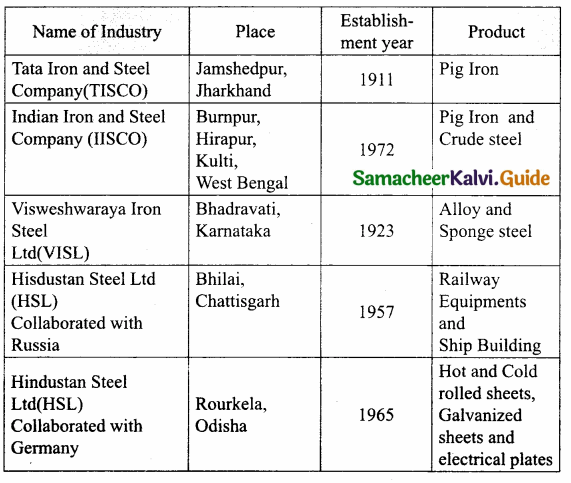
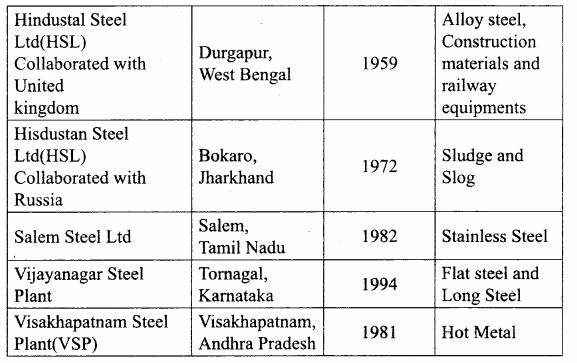
VI. On the outline map of India mark the following.
Question 1.
iron ore production centres.
Answer:
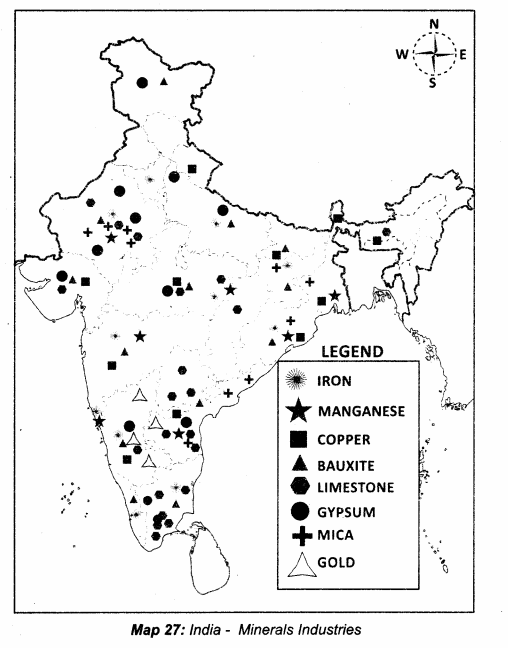
Question 2.
Centres of Petroleum and Natural Gas production.
Answer:
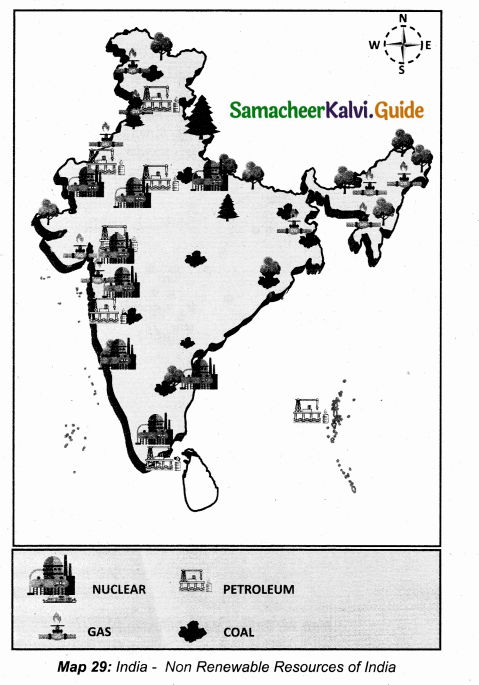
![]()
Question 3.
Coal mining centres.
Answer:

Question 4.
Areas of cultivation of cotton.
Answer:
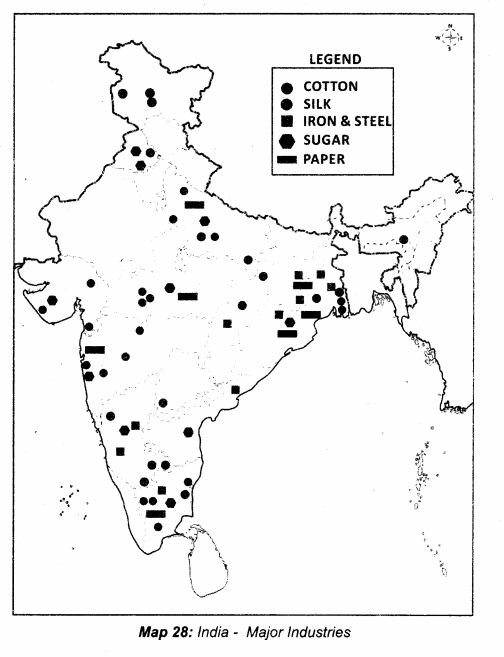
Question 5.
Iron and Steel industries.
Answer:
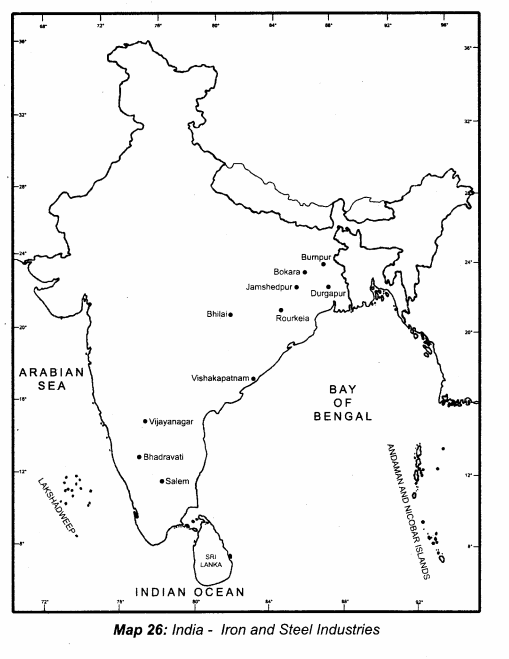
Samacheer Kalvi 10th Social Science Resources and Industries Additional Important Questions and Answers
I. Choose the correct answer
Question 1.
The ………………. is called as mineral oil.
(a) Petroleum
(b) Coal
(c) Natural gas
(d) Mica
Answer:
(a) Petroleum
![]()
Question 2.
Manchester of India is ……..
(a) Delhi
(b) Mumbai
(c) Chennai
Answer:
(b) Mumbai
Question 3.
The ………………. is the largest oil field in India producing 65% of oil.
(a) Ankaleshwar
(b) Mumbai high
(c) Kalol
(d) Surma valley
Answer:
(b) Mumbai high
Question 4.
Chotta Nagpur plateau is noted for ……..
(a) Natural vegetation
(b) Mineral resource
(c) Cotton cultivation
Answer:
(b) Mineral resource
Question 5.
TamilNadu produces about ………………. % of the total thermal electricity produced in India.
(a) 5
(b) 20
(c) 18
(d) 90
Answer:
(a) 5
Question 6.
In India most of the Iron and Steel industries are located in the …… plateau.
(a) Chott Nagpur
(b) Deccan
(c) Malwa
Answer:
(a) Chott Nagpur
Question 7.
Areas near ………………. district has the largest concentrations of wind farm capacity at a single location in the world.
(a) Ramanathapuram
(b) Tuticorin
(c) Thiruvallur
(d) Kanyakumari
Answer:
(d) Kanyakumari
Question 8.
The resources that can be reproduced again and again is called ……
(a) Mineral resources
(b) Renewable resource
(c) Natural resource
Answer:
(b) Renewable resource
![]()
Question 9.
Bysinosis is an occupational lung disease caused by exposure to:
(a) natural gas
(b) cotton dust
(c) coal power
(d) automobile
Answer:
(b) cotton dust
Question 10.
Lignite is extracted in Tamil Nadu …….
(a) Kadaloor
(b) Neyveli
(c) Madurai
Answer:
(b) Neyveli
Question 11.
National News Print and Papermills (NEPA) is in ………………. state.
(a) Odisha
(b) West Bengal
(c) TamilNadu
(d) Madhya Pradesh
Answer:
(d) Madhya Pradesh
Question 12.
Sugar bowl of India is …….
(a) West Bengal
(b) Uttar pradesh and Bihar
(c) Mumbai
Answer:
(b) Uttar pradesh and Bihar
![]()
Question 13.
The ………………. is the largest producer of electronic goods in India.
(a) Bengaluru
(b) Mysuru
(c) Delhi
(d) Jaipur
Answer:
(a) Bengaluru
Question 14.
The leading producer of electronic goods is ……..
(a) Bangalore
(b) Coimbatore
(c) Hyderabad
Answer:
(a) Bangalore
Question 15.
………………. is an aluminium ore.
(a) Manganese
(b) Magnesium
(c) Bauxite
(d) Anthracite
Answer:
(c) Bauxite
![]()
II. Match the following
Question 1.
Match the Column I with Column II.
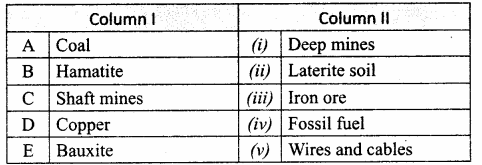
Answer:
A. (iv)
B. (iii)
C. (i)
D. (v)
E. (ii)
Question 2.
Match the Column I with Column II.

Answer:
A. (iii)
B. (v)
C. (ii)
D. (i)
E. (iv)
![]()
Question 3.
Match the Column I with Column II.

Answer:
A. (iii)
B. (iv)
C. (v)
D. (ii)
E. (i)
![]()
III. Answer the following questions briefly
Question 1.
What are the features of copper and aluminium?
Answer:
- Malleability
- Expandability
- Good conductor of heat and energy (electricity)
Question 2.
Where was the first hydro-electric power station in India established?
Answer:
The first hydro-electric power station in India was established at “Darjeeling” in 1897.
Question 3.
In which type of rocks is limestone found?
Answer:
Limestone is found in sedimentary rocks.
Question 4.
What is the origin of the word petroleum?
Answer:
The word petroleum is derived from two Latin words petro (Rock) and Oleum (oil) thus petroleum is oil obtained from rocks of the earth. It is also called as mineral oil.
Question 5.
Name any five software centres.
Answer:
- Chennai
- Bangalore
- Mysore
- Hyderabad
- Coimbatore
![]()
Question 6.
When was the Nuclear power programme initiated in India and where was the first Atomic Power station was set up?
Answer:
- Nuclear Power programme was initiated in the 1940s, when “ Tata Atomic Research Commission was incorporated in August 1948.
- The 1st nuclear power station was set up at Tarapur near Mumbai in 1969.
Question 7.
What are the raw materials for the paper industry?
Answer:
Woodpulp, bamboo, salai, Sabai grasses, waste paper and bagasse
Question 8.
Write a note on NPCIL.
Answer:
- The Nuclear Power Corporation of India Limited ( NPCIL) is wholly owned by the Government of India.
- It is a Public sector undertaking.
- Responsible for the generation of nuclear power for electricity.
- Administered by the Department of Atomic Energy (DAE). It is responsible for designing, constructing and operating the Nuclear power stations in India.
![]()
Question 9.
What are the major centres of the automobile industry?
Answer:
Mumbai, Chennai, Kolkata, New Delhi, Pune, Ahmedabad, Lucknow, Satara and Mysore.
Question 10.
Where are the centres of IT parks located in India?
Answer:
Centres of IT parks in India are located in Chennai, Coimbatore, Thiruvananthapuram, Bengaluru, Mysuru, Hyderabad, Vishakapatnam, Mumbai, Pune, Indore, Gandhinagar, Jaipur, Noida, Mohali and Srinagar.
IV. Distinguish between
Question 1.
Paper industry and Iron and Steel industry.
Answer:
Paper industry
- Forest-based industry.
- Serve as an index for education and literacy.
- Wood pulp, Bamboo, bagasse are some of the basic raw materials.
Iron and Steel industry:
- Mineral-based industry.
- Key industry for industrial development.
- Iron ore and Manganese are the main raw materials.
Question 2.
Solar and Wind energy.
Answer:
Solar energy:
- Conversion of sunlight into electricity.
- Photo voltoic cells or use of lenses, mirror and tracking system is used.
- Installation cost is more and different applications is required as per the need.
- Occupy more space.
Wind energy:
- Conversion of energy is from the flow of wind.
- Wind turbines are used.
- Installation cost is comparatively less.
- Occupy less space.
![]()
Question 3.
Difference between Manganese and Mica.
Answer:
Manganese:
- It is a Metallic mineral.
- Very hard and brittle in nature.
- Raw material for iron and steel basic raw material for alloying.
Mica:
- It is a Non-Metallic mineral.
- Translucent, splitable into thin sheets, elastic and incompressible.
- Exclusively used in electrical goods and also for making lubricants, paints, varnishes etc.
Question 4.
Iron and Steel industry and Software industry.
Answer:
Iron and Steel industry:
- Age old industry.
- Depend upon minerals.
- Large scale industry.
- Began in 1907.
Software industry:
- Recently developed industry.
- Depend upon skill and knowledge (technical).
- Small and medium scale industry.
- Began in 1970.
![]()
V. Answer the following in a paragraph
Question 1.
Enumerate the automobile industry as the fast-growing industry of India.
Answer:
The first automobile industry was established at the Premier Automobiles Ltd at Kurla (Mumbai) in 1947 and the Hindustan Motor Ltd at Uttarpara (Kolkata) in 1948. At present India is the 7th largest producer of automobile manufactures which includes two wheelers, commercial vehicles, passenger cars, Jeep, scooty, scooters, motor cycles mopeds and three wheelers.
Among the production of two wheelers, motorcycles are manufactured at Faridabad, Haryana and Mysore. While scooters are manufactured at Lucknow, Satara, Akudi (Pune), Panki (Kanpur) and Odhai (Ahmedabad). The cars produced at Haryana, Kolkata, Mumbai and Chennai are Maruti, Ambassador, Fiat, Ford and Hyndai etc. Presenceof foreign car companies such as Mercedes Benz, Fiat, General Motors, Toyota and the recent entry of passenger cars manufacturers BMW, Audi, Volks Wagen and Volvo makes the Indian automobile sector a special one.
Several new joint venture agreements for the manufacture of cars have recently been signed by the Indian companies and renowned car manufacturers of the world. The Indian auto industry is said to take a big leep in the near fixture. This expected to provide much more competitive environment to the industry and a wide choice of ultra modem cars to the consumers. This is the fast growing industry in India.
Question 2.
What are the different forms of Iron ore and their nature?
Answer:
Iron ores are rocks and minerals from which metallic iron can be economically extracted.
![]()
The different forms of Iron ore are:
| Form of Iron ores | Iron content % |
| Magnetite | 72.4% |
| Haemetite | 69.9% |
| Goethite | 62.9% |
| Limonite | 55% |
| Siderite | 48.2% |
Nature: The ores are usually rich in iron oxides and vary in colour from dark grey, bright yellow or deep purple to rusty red.
Question 3.
Write about the uses of Coal and its areas of distribution.
Answer:
- Coal is a non-renewable resource. It is available in the form of sedimentary rocks.
- It has close association with the industrial development of any country.
Uses: Coal is an important source of energy in India with its varied and innumerable uses
- It is converted into gas, oil and thermal power electricity.
- Besides it forms a basic raw materials for the production of chemicals, dyes, fertilizers, paints, synthetic and explosives.
- Distribution: Indian coal is mostly associated with Gondwana region and is primarily found in peninsular India.
- The States of Jharkhand, Odisha, West Bengal and Madhya Pradesh alone account for nearly 90% of coal reserves of the country. About 2% of India’s coal is of tertiary type and is mostly in Assam and Jammu and Kashmir.
- Jharkhand is the largest coal producing state in the country. Indian lignite (brown coal) deposits occur particularly in Tamil Nadu ( Neyveli), Puducherry and Kerala.
Question 4.
Give an account on Automobile industry in India.
Answer:
Automobile industry’ is one of the most dynamic industrial groups in India. India is the 7th largest producer of automobile manufacturers.
Distribution: The automobile industries are found in four clusters viz: Delhi, Gurgaon and Manesar in North India.
West India: Pune, Nasik, Halol and Aurangabad East India: Jamshedpur and Kolkatta South India: Chennai, Bengaluru and Hosur.
Major-Indian companies which manufacture commercial vehicles: Tata motors, Ashok Leyland, Mahindra and Mahindra, Eicher motors and Ford motors.
Foreign companies which manufacture commercial vehicles: Hyundai, Mercedes Benz , ITEC, MAN.
Automobile industries in India manufactures two wheelers passenger car, Jeep, Scooty, Scooter, Mopeds, Motorcycles and three wheelers.
Passenger car manufacturers: Tata motors, Maruti Suzuki , Mahindra and Mahindra and Hindustan motors are Indian companies.
Foreign car companies in India: Mercedez Benz, Fiat, General motors, Toyota, recent entry BMW, Audi, Volkswagon and Volvo.
Two wheeler manufacturing is dominated by Indian companies like Hero, Bajaj Auto and TVS.
Major centres of Automobile industries: Mumbai, Chennai, Jamshedpur, Jabalpur, Kolkata, Pune, New Delhi, Kanpur, Bengaluru, Satara, Lucknow • and Mysuru. Chennai is named as “Detroit of Asia” due to the presence of major automobile manufacturing units and allied industries around the city.
![]()
Question 5.
What are the major challenges faced by the Indian industries?
Answer:
Some major challenges faced by industries in India are:
- Non-availability of large blocks of land.
- Shortage and fluctuation in power supply.
- Non-availability of cheap labourers.
- Poor access to credit.
- High rate of interest for borrowed loan.
- Lack of technical and vocational training for employees.
- In appropriate living conditions nearby industrial areas.
VI. On the outline map of India mark the following


![]()


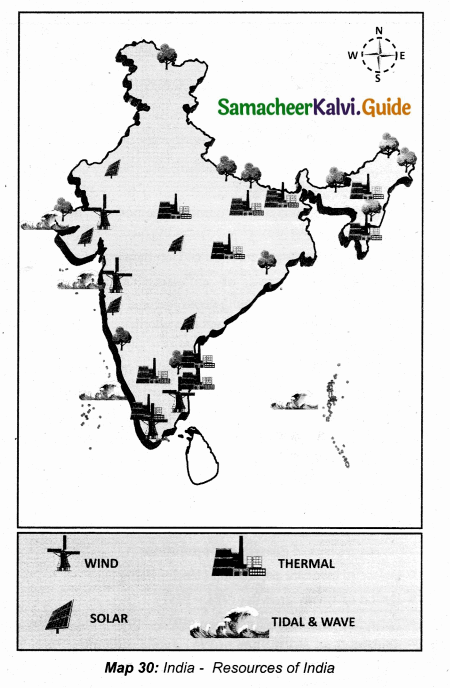
Question 1.
Any two places producing limestone
Answer:

Question 2.
Any two Nuclear power stations
Answer:

![]()
Question 3.
Any two Thermal power stations in Tamil Nadu
Answer:

Question 4.
Wind farm places (any 2)
Answer:
